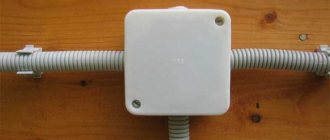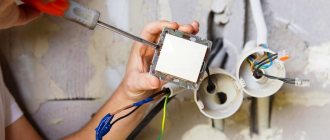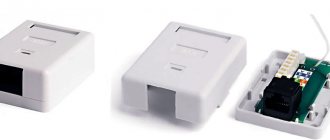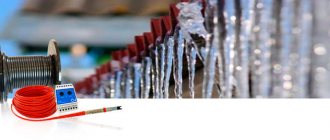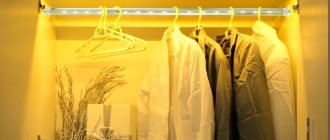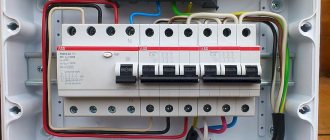The main difficulty that you may encounter when laying electrical wiring in a private house, apartment or specific room is the need to switch them inside the junction box.
There are several common mistakes associated with this process, and if you want to avoid them, there are a number of important points to consider. Laying out the wires into grooves or cable channels is not difficult. The distribution box is another matter: when working with it, you need to follow certain rules and recommendations.
Purpose of branching boxes
Electrical wiring should be divided into separate groups depending on the electricity consumer. For these purposes, special electrical products are used that perform important functions:
- increasing the level of fire safety;
- aesthetics.
The cables are hidden under the box body, which provides reliable protection from mechanical damage and significantly extends the service life of the wiring as a whole. If we consider the installation principle, then devices are divided into built-in and external, suitable for open wiring. The first are placed inside pre-prepared niches, the second are attached to the surface of any wall. There is also a special outdoor box.
Main function of distribution box
Using this electrical product, you can significantly reduce the cost of organizing electrical wiring. Without this element, each electrical appliance would have to be connected to a separate cable, which would increase the number of channels required for installation and spoil the appearance.
Proper distribution of the cable inside the box will increase the safety of residential and non-residential rooms. This is due to the insulation of connecting points with flammable materials contained in the wall. The design of the equipment is thought out to the smallest detail, therefore it guarantees ease of repair work.
But the main function of the box is related to the uniform distribution of electrical energy between all consumers installed in the room. In addition, the product structure takes into account potential expansion due to the addition of new branches of the electrical circuit.
Why are they called differently?
This electrical equipment is called differently, from distribution to branch or junction box. The principle of operation is always identical: the box is the head center, into which electrical energy is supplied from the source, after which it is distributed among different branches, supplying voltage to sockets, switches and lighting fixtures. That is why it got its name – “distribution”. The alternative name “branch” appeared due to the fact that one wire enters the box and several cables exit.
Soldering products are so called because of the method used for switching wires inside the case: after twisting, they must be soldered. Despite the huge variety of modern methods of connecting cables in boxes (terminal blocks, sleeves, clamps, welding), they are still called soldering.
Another synonym for the device was the word “exclusive”. You can hear it only among people involved in the electrical installation industry. In fact, the word is derived from two other terms - distribution and connection: first the wires are distributed into branches, and then they are connected. Following this principle, it is easy to guess where another name for the box came from - “connecting”.
Thus, when going to the store to buy a distribution box, you should not be surprised if the product you need is on the counter, but under a different name. Also pay attention to the dimensions of the device, according to which you will have to create a recess in the wall. For example, rectangular boxes for an apartment are usually produced in a standard size - 100x100x50 mm.
Is it possible to do without installation junction boxes?
Theoretically, this option is possible and acceptable, but to make sure that it is practically impossible to implement, it is enough to imagine a simple picture: an introductory electrical panel is installed at the entrance to the apartment, boxes are not used in the rooms, so you have to pull separate cables to each switch, socket and lighting device. This will lead to significant costs for the purchase of cables, expansion and deepening of the grooves (or installation of wider cable channels, which will disrupt aesthetics). Conclusion: installing a distribution box is an economically feasible and rational solution.
Many people mistakenly believe that an additional connection assembly appearing inside the distribution box (in line with the input panel from a particular outlet) will lead to poor safety, while a solid cable is much better. In fact, if everything is done correctly and correctly, then the selected switching method will not pose a threat. Finally, a product like this makes it easier to find faults on the line, so you don't have to dig through the entire wall to find a damaged section of the electrical circuit.
Solder box parameters
Below are three different types of shields and their characteristics.
Junction box for external wiring IP54-IP56
It is mainly used in conjunction with corrugated metal hoses. The product is made of ABS plastic. Protection level IP54-IP56.
Note! All subtypes of this box do not have seals according to the European standard, which provide a high level of protection.
Such shields are mainly installed on walls. Can be located in places of high humidity (bathroom). They are quite safe and have a nice minimalistic design.
Drywall box
Soldering shield for drywall
Used for internal wiring in conjunction with corrugated sleeves. The product is made of ABS plastic or polystyrene. Protection level IP 30. The box has holes where the wires will be inserted. They are mainly installed on ceilings using self-tapping screws with claws (included).
You may be interested in this Features of aluminum wire
Important! Sometimes these tabs can damage the ceiling, so there is no need to screw them in with force.
Economy shield for external wiring IP55
Products of the JBR and JBS type for external wiring are used in conjunction with corrugated hoses. The product is made of ABS plastic.
Main types
Protection level - IP55. The cheapest option of the three above. These boxes are designed with gaskets for connecting corrugated pipes and providing a high level of protection. Attaches to walls and ceilings.
These three types are most often used for repair work, but there are also more expensive models.
Types of distribution boxes
Above we indicated the first criterion for classifying boxes - the method of fastening (built-in and external). Regardless of this, the boxes are closed with a tight lid, providing quick access to the contents and integrity of the wiring. If necessary, an electrician can examine the contents of the housing by removing the cover.
The main materials for making distribution boxes are plastic and metal. In the second case, tinned steel sheets and alloys containing aluminum are used. Important condition: the metal box must be reliably protected from corrosion.
If the products are placed at a strategically important site where any damage is unacceptable, then it is recommended to buy a box with a lid with screws and waterproofing gaskets. Metal is more reliable in terms of fire protection, since it is able to maintain the integrity of the contents for several minutes. This time is usually enough to promptly de-energize the network.
Plastic elements are also characterized by certain positive qualities. They are resistant to any oxidation processes and are excellent dielectrics. In both cases, the degree of protection against dust and moisture is at least IP65.
The geometric shapes of the boxes are round, square and rectangular. The former are used in situations where a small number of cables are switched, the latter - a large number. The specific dimensions of the device depend on the cross-section and number of wires.
Advice! If you need to install a distribution box in a concrete wall, then it is much easier to use round-shaped products.
What devices are there?
Modern devices come in two types:
- Internal or hidden.
- External or overhead.
Junction boxes for hidden wiring (right) and overhead type
The former are used, as a rule, for installing hidden wiring, the latter for external wiring. The materials used for their manufacture range from ordinary or non-flammable plastic to metal. It is recommended to ground the latter, although this is often not done out of laziness or negligence. Both of them can have either a regular design or a waterproof or even sealed version. The last two are used in high-risk areas - damp and explosive (basements, warehouses, ships, etc.). The differences between internal and external boxes are not only aesthetics, but also ease of installation. For example, it is much easier to use internal distributors for hidden wiring.
Where and how to install distribution boxes
Usually the boxes are located under the ceiling at a distance of 100-200 mm from it. The specific value depends on the height of the room. If the wiring is hidden, then the product is placed inside the wall to a certain depth so that the surface of the cover is flush with the wall. For open-type electrical wiring, external boxes are suitable.
In accordance with the rules for the construction of electrical installations (PUE), it is important to provide free access to the junction box cover, which is necessary in case of inspection or troubleshooting. If the product is external and attached directly to the wall, then this condition is met automatically.
When placing the device in a wall recess, two requirements must be met. Firstly, you need to know where it is installed, and secondly, you should ensure timely access to the product without compromising its aesthetics. If the latter can be neglected without violating the PUE, then the first requirement is mandatory and important.
You can maintain an aesthetic appearance by gluing beautiful wallpaper, and then carefully trim around the lid of the junction box without removing the part that is glued to it. When choosing alternative finishes, make sure that the color of the surface of the lid and the wall are identical. Try to make sure that if you need to remove the cover, the wall in this place does not collapse. If suspended ceilings are installed, then small hatches should be created to provide access to the boxes.
Potential equalization boxes
Installing a potential equalization box is one way to protect the consumer from possible electric shock. Such devices have found their application in office buildings, apartments and private homes.
Potential equalization box
What is potential difference?
In the case when the potential value of current-carrying objects located in the same room is different, then a voltage arises between them, called a potential difference.
This situation is very dangerous from the point of view of the possibility of electric shock to a person in the room. Most often, this danger occurs in rooms with high humidity (kitchen, bathroom, toilet, shower).
Potential differences in household electrical appliances occur in the following cases:
- current leakage due to damage to the insulation of electrical network elements;
- improper connection of electrical equipment;
- malfunction of energy receiving devices;
- the occurrence of static electricity on device housings;
- the appearance of stray currents in the grounding system.
To avoid the occurrence of such unpleasant situations in the premises, a potential equalization system is organized, which essentially represents the combination of all metal structures into a single circuit.
Wire connection methods
The PUE specifies five main methods for switching two wires:
- twist;
- welding;
- terminal blocks;
- soldering;
- crimping.
Twist
The fastest, simplest, but extremely unreliable switching method. To insulate the wires, use electrical tape, plastic caps or heat shrink tubing.
Twist with mounting caps
The connection made using special mounting caps will be much better and more stable. The products consist of two parts - an outer plastic, non-flammable, and an inner metal, conical shape with threads. The latter allows you to literally screw a cap onto the end of the wire, providing a large contact area and excellent electrical parameters. This method allows you to connect two or more wires without soldering.
To perform the operation, remove up to 20 mm of insulation and twist the wires together. Place a cap on the twist and twist several times. When choosing a cap, be guided by the number of wires to be twisted and their cross-section. This option saves space, allowing you to place the cable more compactly.
Soldering
A standard method of connecting wires using tin and solder. It is characterized by high reliability and durability, but takes much more time.
Welding wires
The first difficulty of the method is that an inverter-type welding machine is required. This option is considered even more reliable and of high quality, allowing you to turn two cores into one. It should be used only in extreme cases: when grounding a private house with a powerful load, connecting pumps or uninterruptible power supplies for operating gas boilers.
Terminal blocks
In accordance with the recommendations in the PUE, when connecting two wires made of different materials, you need to use special screw or spring type clamps. A simple method that requires a screwdriver. Be careful not to overtighten the clamp bolts.
Crimping
This method involves the use of press jaws and sleeves. The latter are selected depending on the cores being connected - aluminum sleeves are used for aluminum, copper sleeves are used for copper, etc. Please note that using pliers you will not be able to ensure a reliable and high-quality connection.
Characteristics
The PROMRUKAV channel talked about the technical characteristics of switchgears.
The characteristics of distribution boxes differ from each other:
- material of manufacture;
- overall dimensions.
Material
Most often, distribution boxes are made of plastic.
The use of this material for production is due to the following advantages:
- plastic has excellent dielectric characteristics;
- plastic is a cheaper material, which generally reduces the cost of production;
- thanks to plastic, the manufacturer can produce junction boxes in any shape and size;
- plastic devices can be additionally equipped with rubberized sealing elements, mounting strips, and bolts;
- Products made of plastic are characterized by a long service life due to the fact that this material is not destroyed during operation.
Metal devices have higher performance properties. Thanks to this, their installation is possible in warehouses, as well as production hangars and workshops. In a word - in any places where you need to firmly fix cables and prevent the negative impact of external factors. Devices made of metal are usually installed by stamping, followed by priming and painting. The lid is attached to the product via a screw connection, and high tightness of the box is achieved through the use of sealing elements and a rubberized seal.
Dimensions
Devices for hidden wiring come in sizes:
- 100x100x50;
- 80x80x40;
- 200x150x80;
- 240x190x90 and others.
The overall dimensions of the device will be different depending on the shape in which the device is made - round or rectangular. The depth of a round box can be 4-5 cm, and the diameter can be from 6.5 to 8 cm.
Rectangular sizes can be as follows:
- the depth of the device, depending on the type and manufacturer, will be from 3.5 to 9 cm;
- the length of the device can be from 4.3 to 38 cm;
- device width - from 7 to 30 cm.
In the video, Andrey Kalugin talked about distribution boxes of different sizes and types.
Basic wiring diagrams
After studying and choosing a method for connecting wires in a junction box, read the information on connecting specific conductors.
How to connect sockets
In most cases, sockets are connected in groups, for which a separate current-carrying line is used. Three cables with two or three conductors go inside the box. Brown usually indicates “phase”, blue - “zero”, yellow-green - “grounding”. There are alternatives to these colors with the following standard - red, blue and black respectively.
The wires need to be grouped by color, folded, pulled and cut to obtain equal lengths. Be sure to do this with a small margin of up to 10 cm to leave room for repeated distribution and switching. Next, perform switching using the selected method. If two wires are connected (without grounding), then the circuit remains the same, only simplified.
Connecting a single-key switch
With switching the switch, things are more complicated. There will be three groups of wires with a different connection. One wire supplies voltage from a nearby box or electrical input panel, the other comes from the chandelier, and the third from the switch.
The phase wire must be fed to the switch connected to the chandelier. Make sure that voltage will only flow to the lighting fixture when the switch is in the closed position. The neutral and grounding wires of the chandelier are connected directly to the panel.
Connecting a two-gang switch
A cable consisting of three wires (without a ground wire, which is connected directly to the box) is laid to a switch with two keys. One wire goes to the common contact of the switch, the second to the first, and the third to the second key. Remember the color of the conductor connected to the common contact.
The phase wire must be connected to a common contact; neutral wires from the input panel and two lighting fixtures are connected directly. The phase wires from the lamps should be connected to the conductors on separate switch keys.
Finally, I would like to remind you to comply with basic electrical and fire safety rules. Never directly connect two conductors made of different metals, such as aluminum and copper. If such switching cannot be avoided, then use terminal boxes.
Make sure that the phase, neutral and ground wires are connected correctly. If you confuse “phase” and “ground”, you can cause a short circuit. Following the proverb “measure twice, cut once,” before hiding a built-in distribution box under decorative elements, make sure that all consumers connected through it are in working order.
Reliability of junction boxes
When considering such a scheme, the question immediately arises: how will the use of boxes affect the reliability of the entire structure? There are so many connections, and even so many consumers on one wire... That is why there is an opinion that distribution boxes are evil.
It is worth slightly disappointing the skeptics. With correctly selected junction boxes and types of connection of wires of the appropriate cross-section, reliability will practically not suffer. It will decrease somewhat if, say, there is a flood from above (the boxes will be flooded with water), but, firstly, this situation is abnormal, and secondly, a correctly made connection will not survive such a thing. Well, if you have regular floods, you can use special waterproof junction boxes with terminals. And in general, even if the reliability of the electrical wiring decreases by a couple of percent, it’s worth it, since you don’t have to tear apart the entire house to find the slightest fault, and then completely destroy it in order to eliminate this fault.
External junction boxes
This type of box is used in electrical circuits with exposed wiring. That is, when wires are laid over the finishing of walls, ceilings and floors. Such boxes do not require gating, but taking into account modern standards, such solutions are not used in residential premises. In addition, such wiring looks rather ugly.
A junction box for open wiring can be of various sizes, because sometimes a large number of twists must fit in it. Most often, large products are made in a square shape and have several holes for entering wires on each side. Standard boxes are also produced, but such a junction box 100x100x50 mm is sometimes not able to accommodate the required number of wires. The holes are closed either with plastic plugs that need to be broken out, or with rubber sleeves that can simply be cut to the shape of a cable or corrugated pipe.
For round boxes, the entries are supplemented with specially shaped sleeves made of plastic, which promote tightness during installation. Because of this, boxes for open wiring are divided into three- and four-arm, according to the number of possible inputs.
The junction box for open wiring can be hidden in a special plastic box, which can be easily matched to the box in color or design. This option greatly simplifies the work of installing electrical wiring.
The covers of round products are usually fastened either with screws or on threads with a large pitch. If a square junction box of 100x100x50 mm is used, then the lid is put on with a slight interference fit. The main thing is not to lose it during installation, since it is sometimes impossible to find exactly the same one, and they are not sold separately at all. Therefore, boxes are often sold with lids hanging separately from a clamp.

